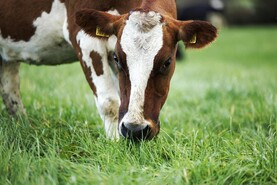Despite grazing conditions being difficult for most of May, grass quality on Dairylink Ireland farms has held up and can support up to 20 litres of milk production.
Programme adviser Aidan Cushnahan took grass samples from Dairylink farms over recent weeks. The samples were taken in paddocks that cows were about to graze, with total covers typically sitting around 3,000kg DM/ha (1,500kg DM/ha available).
The Trouw Nutiopt Dairy Model was used for the analysis and it measures common parameters such as metabolisable energy (ME) and crude protein (CP), as well as acid-loading potential and rumen unsaturated fatty acid load.
A summary of the results from Dairylink farms are outlined in Table 1. Aidan points out that most samples had a ME content over 12 MJ/kg DM, which is above average for the time of year.
It shows that the efforts that Dairylink farmers put in with measuring and budgeting grass pays off by producing a sward with a high leaf content and nutritional value.
If it is assumed that cows can achieve an average dry matter (DM) intake of 14kg/cow/day, the resultant energy intake in most cases should be sufficient to support maintenance (M) plus 20 litres/cow/day under good grazing conditions.
Of course, this level of DM intake was not possible when weather was poor, but it shows what is possible when grazing conditions are ideal.
The advice to Dairylink farmers when conditions were tricky during May was to adjust feed settings to M+15 for cows and M+12 for first-lactation heifers, but this was reviewed as soon as the weather improved.
The samples taken at Frank Goodman’s farm indicated that the grass had a lower ME content and therefore a lower milk production potential than other samples tested.
“It is not exactly clear why the ME content was lower because the grass looked to have a high leaf content.
“The wet conditions experienced on the sampling day appeared to have an impact on the sugar content and this may have had some bearing on the results,” Aidan said.
The protein content of all samples from Dairylink farms was above 20%, but like ME content, this is expected to decline as the growing season progresses.
Steps to stop butterfat depression
Research suggests that increases in acid loading potential and rumen unsaturated fatty acid load (RUFAL) can have a negative impact on butterfat production.
Acid loading appeared to be relatively high in grass samples from Dairylink farms. In general, the risk of butterfat depression is considered low when cows are grazing grass with an acid loading value below 34.
“On the Dairylink farms, it possible that the higher acid loading could be due to the relatively high sugar values and, in some cases, low fibre (NDF) content of the samples,” said programme adviser Aidan Cushnahan.
He points out that, while it is not possible to alter the composition of the grass to minimise a butterfat drop, you do have control over concentrate supplementation.
“If acid loading is high, avoid feeding supplements with a significant amount of wheat. This is because the starch should also help minimise the effects of high RUFAL intakes,” Aidan explained.
“Instead, include higher levels of digestible fibre such as soya hulls and sugar beet pulp to help reduce acid loading and maintain butterfat production.
“The acid load value should also decline as the grazing season progresses,” he added.
Looking at RUFAL values, the Dairylink samples did not exceed 16, which is considered the threshold where it may cause a reduction in butterfat.
“Increases in RUFAL intake have been observed in grass grazed from the second rotation through to June. It has also been suggested swards which are grazed at suboptimal grazing covers, say below 2,500 kgDM/ha cover, or are high in protein, may have higher RUFAL concentrations,” explained Aidan.
Nitrogen update
According to Claire Beckett from Trouw Nutrition, RUFAL levels have generally been lower than usual so far this year.
She suggests this could be due to lower levels of nitrogen uptake and utilisation with the cooler than normal temperatures experienced in May.
If RUFAL values in grass are high, ingredients such as maize distillers, dark grains, and brewers grains, should be minimised as these feeds add to RUFAL intakes.
“The inclusion of digestible fibre to reduce acid loading should also help as the effects of high RUFAL intakes.
“If total pre-grazing grass covers are consistently around 2,500 kgDM/ha (1,000kg DM/ha available), take steps to slow the grazing rotation to allow covers to build up,” Aidan said.






 This is a subscriber-only article
This is a subscriber-only article











SHARING OPTIONS: